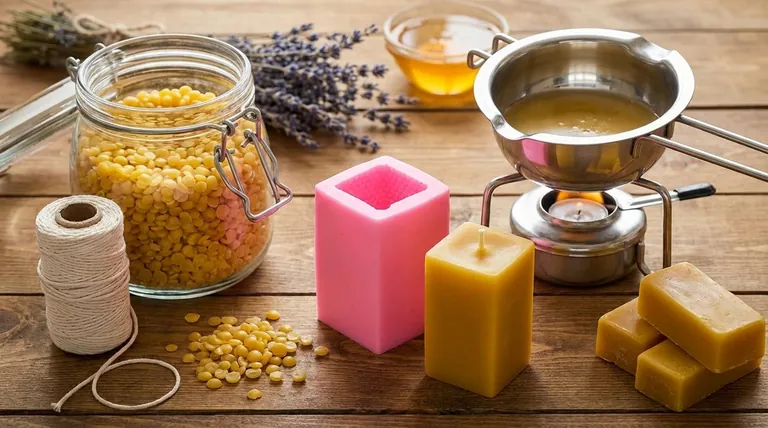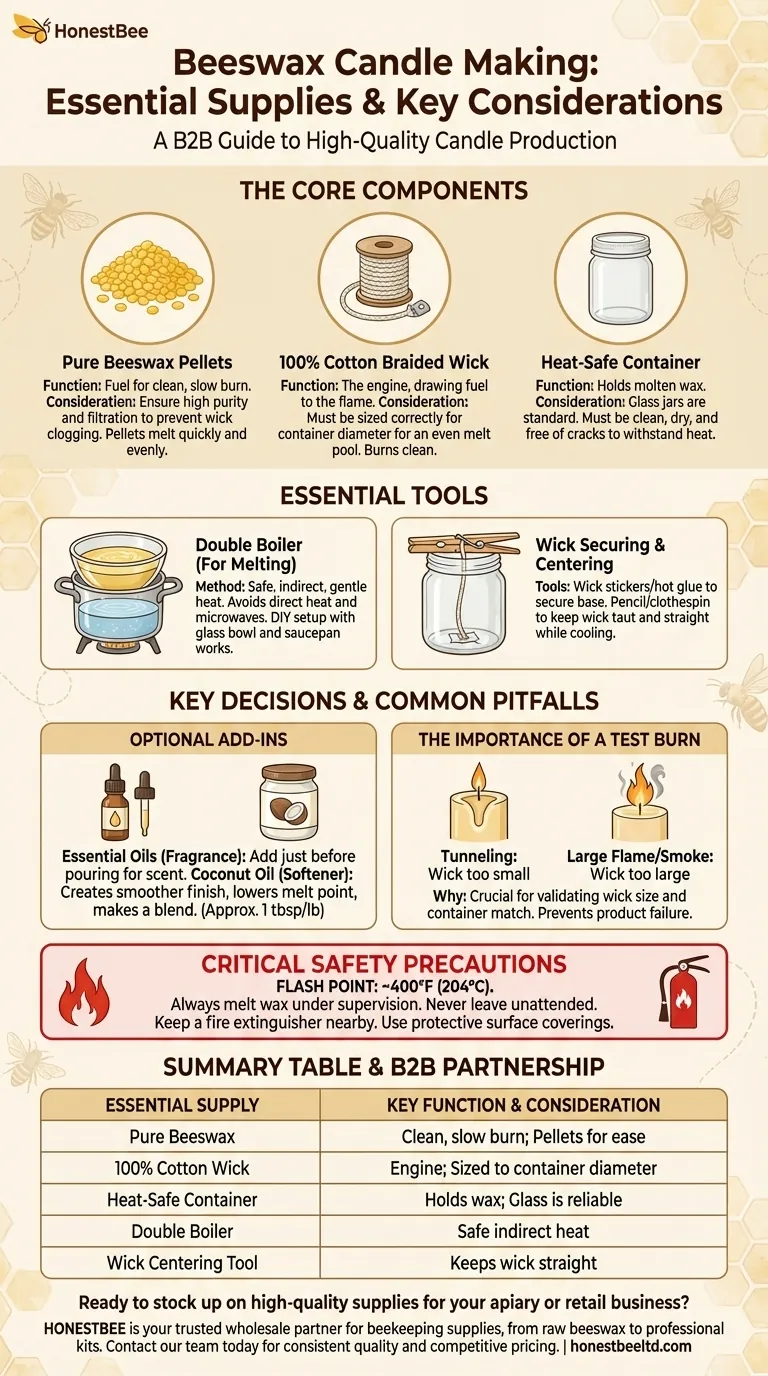To make beeswax candles, you need three primary components: pure beeswax, a 100% cotton wick, and a heat-safe container. The essential tools are simply a method for safely melting the wax, like a double boiler, and a way to hold the wick centered while the candle cools.
The success of your beeswax candle doesn't depend on complex equipment, but on the fundamentals: using clean wax, choosing the correct wick size for your container, and maintaining a safe, controlled melting process.

The Core Components: Wax, Wick, and Container
Understanding the role of each primary material is the first step toward creating a high-quality, clean-burning candle.
Selecting Your Beeswax
Beeswax is available in blocks or, more commonly for hobbyists, as beeswax pellets. Pellets are recommended for beginners as they are easy to measure and melt quickly and evenly.
The single most important factor is wax purity. Ensure your wax is clean and properly filtered. Debris in the wax will clog the wick, causing the flame to sputter or extinguish itself.
Choosing the Right Wick
The wick is the engine of your candle. For beeswax, always use 100% cotton braided wicks, as they provide a clean burn without releasing toxins.
Wick size is critical and must be matched to the diameter of your container. Because beeswax burns hotter and slower than paraffin or soy wax, it requires a specific wick size to ensure the wax melts evenly across the entire surface.
Finding a Suitable Container
Almost any heat-resistant container can be used, with glass jars being the most common choice. Ensure the container is clean, dry, and free of any cracks or chips that could compromise its integrity when filled with hot wax.
Essential Tools for the Process
You do not need a dedicated professional setup. Basic kitchen equipment, used with care, is perfectly sufficient.
For Melting the Wax
The only safe way to melt beeswax is with indirect, gentle heat. A double boiler is the ideal tool for this.
If you don't have one, you can easily create a substitute by placing a heat-resistant glass bowl or pouring pot over a saucepan containing a few inches of simmering water. Never melt beeswax directly on a stovetop or in a microwave.
For Securing and Pouring
You will need a way to secure the wick to the bottom of your container before pouring. A dot of hot glue or a wick sticker works perfectly.
To keep the wick centered and taut while the wax cools, simply lay a pencil or clothespin across the top of the container and secure the wick to it. An old ladle or a heat-resistant pouring pot is useful for transferring the molten wax into your container.
Key Decisions and Common Pitfalls
Moving beyond the basics, a few key decisions will determine the quality and character of your final product.
To Add or Not to Add Oils
While pure beeswax has a wonderful, subtle honey scent on its own, you can add essential oils for fragrance. If you choose to do so, add them when the wax is removed from the heat, just before you pour.
Some makers add coconut oil to their beeswax. This softens the wax, can create a smoother finish, and may promote a more consistent burn, but it means the final product is a blend rather than a pure beeswax candle.
The Importance of a Test Burn
The most common point of failure for beginners is incorrect wicking. A wick that is too small will "tunnel," leaving a wall of unmelted wax. A wick that is too large will create a dangerously large flame and excess smoke.
Always consider making a single, small test candle first to ensure your wick and container combination works as expected.
Critical Safety Precautions
Working with hot wax requires your full attention. Beeswax is flammable with a flash point around 400°F (204°C).
Always melt wax under supervision and never leave it unattended. Keep a fire extinguisher nearby and ensure your workspace is protected with newspaper or parchment paper to catch any drips.
Making the Right Choice for Your Goal
Select your supplies based on the type of candle you want to create.
- If your primary focus is making your first simple candle: Stick to the basics of pure beeswax pellets, a pre-tabbed cotton wick sized for your jar, and a double boiler.
- If your primary focus is creating scented candles: Choose high-quality essential oils known to perform well in hot wax and add them right before pouring.
- If your primary focus is achieving a perfectly smooth top: Consider adding a small amount of coconut oil (around 1 tablespoon per pound of wax) to your mixture.
Ultimately, mastering the craft of candle making is an exercise in appreciating how simple, high-quality materials work together.
Summary Table:
| Essential Supply | Key Function & Consideration |
|---|---|
| Pure Beeswax | Provides a clean, slow burn. Pellets are easiest for beginners. |
| 100% Cotton Wick | The candle's engine. Must be sized correctly for the container diameter. |
| Heat-Safe Container | Holds the molten wax. Glass jars are a common, reliable choice. |
| Double Boiler | Provides safe, indirect heat for melting wax. A DIY setup works well. |
| Wick Centering Tool | A pencil or clothespin to keep the wick straight while wax cools. |
Ready to stock up on high-quality supplies for your apiary or retail business?
HONESTBEE is your trusted wholesale partner for beekeeping supplies and equipment. We supply commercial apiaries and distributors with the reliable materials needed for success, from raw beeswax to professional candle-making kits.
Contact our wholesale team today to discuss your needs and discover how we can support your operations with consistent quality and competitive pricing.
Visual Guide

Related Products
- 3D Square Honeycomb Pillar Silicone Candle Molds for Making Beeswax Candles
- 3D Beehive Silicone Skep Wax Candle Molds for Candles
- Electric Flatting and Embossing Machine with Tray for Beekeeping
- Wooden Bee Brush with Triple Row Artificial Fiber for Beekeeping
- Honey Wax Separating Wax Press with Metal Screw Wax Separator Machine
People Also Ask
- How can beeswax be acquired for candle making? Sourcing Tips for Quality & Convenience
- How long should you wait before removing a beeswax candle from the mold? The Key to Perfect Demolding
- How long should you let the beeswax cool in the mold? Master the Perfect Timing for Pliable Sheets
- How do you secure a silicone mold for candle making? Prevent Leaks and Achieve Perfect Candles
- What types of molds can be used for pouring melted beeswax? Choose the Right Mold for a Perfect Release



















